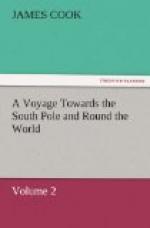As we advanced to N.N.W., along a fine coast covered with woods, we perceived low land that extended off from the bluff-head towards the island above mentioned, but did not seem to join it. It was my intention to have gone through the channel, but the approach of night made me lay it aside, and steer without the island. During the afternoon, we passed some small isles lying under the shore; and observed some projecting points of unequal height, but were not able to determine whether or no they were connected with the main land. Behind them was a ridge of hills which terminated at the bluff-head. There were cliffs, in some places of the coast, and white patches, which we judged to be chalk. At ten o’clock, being the length of the isle which lies off the head, we shortened sail, and spent the night in making short boards.
At day-break on the 25th, we were on the north side of the island (which is of a moderate height, and three leagues in circuit,) and steered west for the bluff-head, along the low land under it. At sun-rise an elevated coast came in sight beyond the bluff-head, extending to the north as far N.W. by W. After doubling the head we found the land to trend south, a little easterly, and to form a large deep bay, bounded on the west by the coast just mentioned.
Every thing conspired to make us believe this was the Bay of St Philip and St Jago, discovered by Quiros in 1606. To determine this point, it was necessary to proceed farther up; for at this time we saw no end to it. The wind being at south, we were obliged to ply, and first stretched over for the west shore, from which we were three miles at noon, when our latitude was 14 deg. 55’ 30” S., longitude 167 deg. 3’ E.; the mouth of the bay extending from N. 64 deg. W., to S. 86 deg. E., which last direction was the bluff-head, distant three leagues. In the afternoon the wind veering to E.S.E., we could look up to the head of the bay; but as the breeze was faint, a N.E. swell hurtled us over to the west shore; so that, at half past four o’clock p.m., we were no more than two miles from it, and tacked in one hundred and twenty fathoms water, a soft muddy bottom. The bluff-head, or east point of the bay, bore north 53 deg. east.




